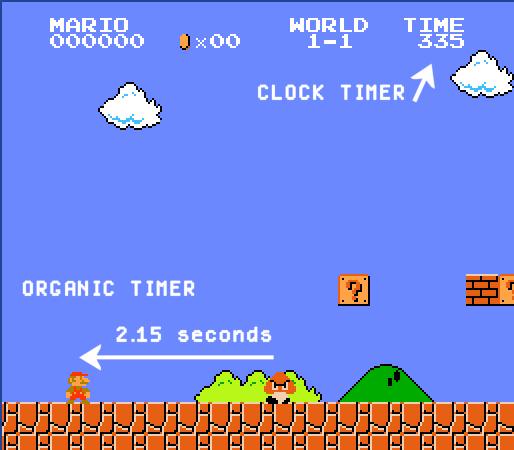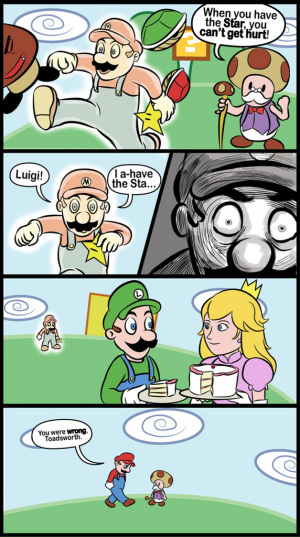I'm not interested in discussing feelings or emotions. As far as I'm concerned and for the purposes of this blog/article, the uncomfortable, unsettling feelings that are evoked from a video game are not worth talking about. It's not that I devalue emotions in any way. Rather, the way we feel and how we come to these reactions is a more complicated and very personal matter. The video game industry is having a hard enough time discussing the quality of a game's design without hiding behind a language wall filled with personal emotional accounts, jargon about game stories, or analogies to movies. As is my custom here at Critical-Gaming, I intend to equip you with language necessary to objectively analyze tension within a video game.
Contrary to what many think, tension stems from the known not the unknown. A dark alleyway at night isn't scary because you don't know what's lurking in the shadows. The alleyway is scary because of the type of person or animal that you know might be lurking there and the kind of harm they can inflict on you. In extreme states of uncertainty where one doesn't know where they are or what's going on, one acts stupefied, not stressed out. In such a situation people often look from side to side trying to gather information perhaps blinking frequently or asking questions. There is much more that we don't know than we know. If tension or stress came from what is unknown, we'd all be stressed to our deaths by now.
Though I think the phrase "ignorance is bliss" is a preposterous view, one can't react to what one isn't aware of in any capacity. It is when we know things that we begin to feel tension. When we know we're in danger or we become aware that we are being threatened by a loss of some kind tension is created. Even in the virtual worlds of video games loss is still just as powerful because of how function is always real.
The game rules only apply to half of Mario's experience.
In Jesper Juul's book Half-Real, he talks about how video games exist in a half-real, quasi state. Though the characters in the game aren't real, the forms they exhibit and the rules/functions that govern the game are real. These elements are made real because the player is real. Our time, effort, patience, and even money are all part of the real world that we live in. This is why gamers react so strongly and emotionally to a virtual situation. For example, if a game were to glitch erasing hours of progress, we would feel cheated. If a thief steals some of your virtual money that you've been slowly saving for weeks, you would feel wronged and even get angry. We may not all react in the same ways or to the same degrees, but the important part is that we do react.

Video games employ many different types of tension through loss. Examples include the loss of...
- Lives: (Ikargua/Everyday Shooter/Mario) In some games, the number of lives you have represents the number of mistakes you can make total from the beginning to the end of the game. When you can't earn lives back, "game over" is always in sight.
- Ammo: (Resident Evil) Have you ever saved your rocket launcher or incendiary grenades just in case something fierce crosses your path, and, before you know it, you've beaten the game with tons of ammo left over? Because ammo is limited, gamers often conserve rare or powerful items until they think they need it. The threat of not having ammo or not having enough is shown through our actions.
- Powerups: (Mario) Remember what it felt like to lose that Kuribo's Shoe? Frog Suit? Tanooki Suit? Hammer Suit? Or even the blue shell just because you didn't see that little Goomba coming? You can scour the Mushroom Kingdom looking for a rare powerup, and lose simply from running into a Goomba. When you're flying high in a Tanooki suit, you never want to come back down.
- Weapons: (Halo) In Halo multiplayer, any weapon that you work hard to obtain can be lost and turned against you after death. The loss of a weapon is similar to the loss of a powerup.
- Allies/Units: (Fire Emblem/Advance Wars) If you send your weak tank up against an anti-tank unit, chances are you'll lose that tank. The Fire Emblem games take this idea to the extreme. Once a character dies in Fire Emblem, that's it. No phoenix downs. No cup of wishes. No max revives. Just death. Any Fire Emblem players know the rage, frustration, and utter despair of losing a good character toward the end of a mission.
- Money: (Zelda) The Zelda series contains special enemies that are notorious for stealing your money. Like-likes and thieves are a few examples. From the beginning of the game, rupees are hard earned. So when something or someone takes them from you, you feel wronged and take action into your own hands. Fortunately, you have a sword. And arrows. And bombs. And JUSTICE!
- Progress: (JRPGs) In games where you can't save whenever and wherever you want, there's always the threat of losing progress between saves. JRPGs can be particularly disheartening when players have to replay sections. After all, RPGs have enough static space as they are.
- Control: (Resident Evil 1, Pokemon, Super Mario Strikers Charged) We're all used to the idea of being in complete control in a game and from there doing our best to obtain the gaol. When a game takes away part of that control, loss is created. In Resident Evil 1, the number of times the player could save their game was limited. In Pokemon, your Pokemon can become confused, attracted, sleep, flinched, paralyzed, or disobedient. In any of these cases, the commands you give aren't guaranteed to be executed. In Super Mario Strikers Charged, Wario's super fart cloud reverses the controls of any character it touches.

One of the most widely used elements of tension is the timer. Whether by a ticking clock or by organic means, timers have a way of putting pressure on the player. When on the clock, players don't have time to lollygag or meander around. Decisions must be made in a timely manner, or the player will face the consequences. And all timers, except perhaps those involved in time trials, threaten the player with some type of loss (see above). In this way, tension timers are a type of contrary motion. Let's look at a few examples of tension timers and the type of loss they threaten.
- Metroid: "escape the station/planet." loss of progress. Clock timer. If the player doesn't escape in time, they explode losing all the progress they made getting through the level and defeating the boss.
- Wario Land 4/Shake It: Folded escape. loss of progress. Clock timer. After the player reaches the end of each level (the crease), the level design is folded back on itself. The leisurely journey up until this point sharply contrasts with the escape. A clock timer is set and the player must escape in time.
- 2D Mario Platformers: loss of progress, lives, powerups. Clock timer. Mario is all about saving the princess. Her danger is constant for Mario. So, to keep players moving along with a degree of urgency, a timer is set in every level. Waste too much time, and you're dead. Any time you die in Mario, the player is reset back to Small Mario at the last check point with one less life. This may seem like a harsh penalty, but just think of what the Princess is going through.
- Pixel Junk Eden: loss of progress. Clock timer. If you to explore the 2D world of Eden at your own pace, you better make sure you do it quickly. Once the time is up, you lose just like in Super Mario Brothers. However, players do have the ability to extend their time by collecting time crystals.
- Zelda Phantom Hourglass: Temple of the Ocean King. Loss of progress. Step one foot into this forbidden temple and your life begins to drain away. Fortunately, you're equipped with the Phantom Hourglass that prevents the temples caustic effects for a limited time. Like in PJE, players collect sand throughout the game world to increase their temple time. Unlike in PJE, the enemies in this temple not only threaten your health, but they take away time from the Hourglass as well as resetting Link to the entrance of the floor.
- Zelda Majora's Mask: loss of progress, ammo, and money. Organic timer = 3 day cycle. In the world of Termina, Link finds himself caught up in a repeating 3 day cycle. At the end of every 3rd day, the moon crashes into the planet destroying everything. If the player doesn't reset time, it's game over. If the player does reset time, there's a chance that he/she will lose their progress and any money/ammo they had collected. It's important to note that there are check points, banks, teleportation stations, and weapon upgrades throughout the game to help players minimize any lost progress. Players can also jump forward in time in addition to speeding up and slowing it down creating variable difficulty. So, in the end, players feel a sense of urgency and security.
- Pikmin: loss of allies/ammo. Organic timer = 1 day cycles. At the end of each day, it is the players responsibly to wrap up their endeavours, gather their Pikmin, and return to base. If the player fails to do so or fails to keep track of any Pikmin that are separated from the group, at the end of the day the Pikmin are eaten. If any Pikmin are in the middle of carrying an object, they drop it where they are in the level and are eaten. In this way, progress isn't lost. Only allies.
- Music Rhythm Games: loss of progress. Organic timer = 1 song. Music rhythm games like Guitar Hero, Elite Beat Agents, or Ouendan are interesting examples of tension timers. Instead of the player leading the action in these games, the player must follow along in the exact way the game specifies. Make too many mistakes and you fail out. In this way, the song itself is functionally similar to a door that slowly closes. If you make it to the very end alive, you make it through the door. Otherwise, you lose and have to play the song/level again.
- Ikaruga & Everday Shooter. These two games are structurally similar to music rhythm games. Because each level is set to a timer (Ikaruga) or to song (Everyday Shooter) the player doesn't have to worry about how to kill the enemy targets. If players simply survive until the end of the level/song, they progress. In this way, the timer actually decreases tension by taking away what would otherwise be challenging game objectives.
Another variation of the tension timer is a tempo increase. By slowly increasing the tempo of a game, the player has less and less time to make decisions. Once players fall behind, the end is usually near. Slowly increasing the tempo is an effective way to ease players into a serious challenge. Here are a few good examples.
- Tetris: Organic timer = falling blocks. In Tetris, the falling blocks create a natural timer that sets the pace for this action puzzle game. Though the player can manipulate the landing location and orientation of each falling block, the player can do little to slow its tempo. As a single game progresses, the blocks fall faster and faster increasing the speed at which the room fills. Most "Tetris clones" use tempo increases as well (Meteos, Tetris Attacks, Puyo Pop, Dr. Mario).
- Space Invaders: Organic timer = descending aliens. All the aliens together descend to the planet intending to cause utter destruction to mankind. As you shoot them away, they respond to the assault by increasing in speed, until there is only one speedster left. After clearing each wave, the game speed increases.
- Wario Ware series: Clock timer. The micro games in Wario Ware are short enough. Still, as the player progresses, the tempo of the macro game slowly increases. At some of the fastest speeds, the instructions, game, and result screen can be completed in under 3 seconds.
- Geometry Wars: Organic timer = spawning enemies. The retro evolved mode of this game starts off slow. One easy enemy spawns here. Two simple enemies spawn there. And these front line foes are easily dispensed with. Good thing the tempo picks up. Before a minute of play is over, you're greatly out numbered and having a blast blasting the cluttered cloud of enemies away.
In the next week, I'll examine how tension develops into various types of game climaxes.
